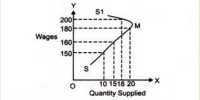In economics, supply refers to the amount of a product that producers and firms are willing to sell at a given price when all other factors being held constant. Usually, supply is plotted as a supply curve showing the relationship of price to the amount of product businesses are willing to sell.
Innumerable factors and circumstances could affect a seller’s willingness or ability to produce and sell a good. Some of the more common factors are:
Good’s own price
The basic supply relationship is between the price of a good and the quantity supplied. Although there is no “Law of Supply” generally, the relationship is positives meaning that an increase in price will induce an increase in the quantity supplied.
Prices of related goods
For purposes of supply analysis related goods refer to goods from which inputs are derived to be used in the production of the primary good. For example, Spam is made from pork shoulders and ham. Both are derived from pigs. Therefore pigs would be considered a related good to Spam. In this case the relationship would be negative or inverse. If the price of pigs goes up the supply of Spam would decrease (supply curve shifts left) because the cost of production would have increased. A related good may also be a good that can be produced with the firm’s existing factors of production. For example, suppose that a firm produces leather belts, and that the firm’s managers learn that leather pouches for smart phones are more profitable than belts. The firm might reduce its production of belts and begin production of cell, phone pouches based on this information. Finally, a change in the price of a joint product will affect supply.
Conditions of production
The most significant factor here is the state of technology. If there is a technological advancement in one good’s production, the supply increases. Other variables may also affect production conditions. For instance, 14 agricultural goods, weather is crucial for it may affect the production outputs.
Expectations
Sellers’ are concerning future market conditions can directly affect supply. If the seller believes that the demand for his product will sharply increase in the foreseeable future the firm owner may immediately increase production in anticipation of future price increases. The supply curve would shift out.
Price of inputs
Inputs include land, labor, energy and raw materials. If the price of inputs increases the supply curve will shift left as sellers are less willing or able to sell goods at any given price. For example, if the price of electricity increased a seller may reduce his supply of his product because of the increased costs of production.
Number of suppliers
The market supply curve is the horizontal summation of the individual supply curves. As more films enter the industry the market supply curve will shift out driving down prices.
Government policies and regulations
Government intervention can have a significant effect on supply. Government intervention can take many forms including environmental and health regulations, hour and wage laws, taxes, electrical and natural gas rates and zoning and land use regulations.
This list is not exhaustive. All facts and circumstances that are relevant to a seller’s willingness or ability to produce and sell goods can affect supply. For example, if the forecast is for snow retail sellers will respond by increasing their stocks of snow sleds or skis or winter clothing or bread and milk.












